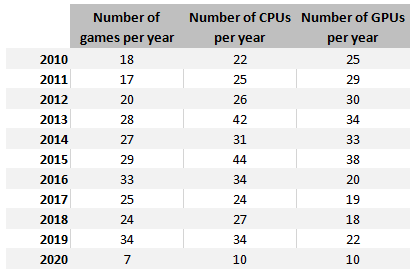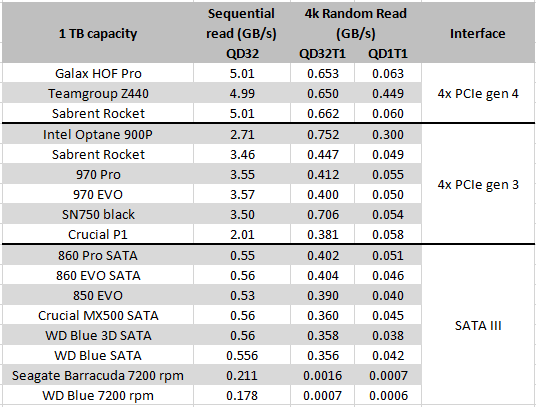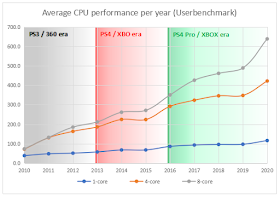 |
*Human generation, not technological generationI've spent the last month or so going through all the games released in the 2010-2020 period and picking out those that I felt had heavy hardware requirements in order to get decent performance and/or those games that were super popular. You can find the list I compiled and the system requirements I was able to find for each game (here) but it wasn't as easy as you might think: there's a lot of conflicting information from many different official and unofficial sources along with incomplete or ambiguous requirements*. However, these are the requirements I've settled on that are attributed to "recommended" performance. Most of the time, that's at 1080p resolution and 30 fps but for certain games that's 60 fps (e.g. racing or more modern titles like Death Stranding).
*I used Steam, Origin, Uplay and various official statements granted to the press shortly before release of each game. In cases where this wasn't possible, I found concensus from various benchmarking and "can I run..." sites and ensured they matched the vague requirements posted to official sources.Aside from the technical requirements, I've also collected benchmarks for the CPUs and GPUs in this list for each year (removing duplicates where they exist) in order to determine an average yearly "performance requirement" and I'll be comparing this against the relative performance of the PS4/PS4 Pro and Xbox One X, where possible in order to see how much more "horsepower" was required of each game running on PC compared to its console version.
Of course, I should preface all this with the statement that these are temporally static results. I "claimed" these results from Passmark, Userbenchmark and Geekbench within as short a time as possible - the reason being is that these are all moving averages - as these benchmarks evolve, the relative values change and even day-to-day I've seen movement in benchmark results that depend on user-submitted data. This means that my data might not be absolutely replicable but replicable by someone performing the same data collection that I did within a similar time frame in the future.
This is all to say, there are certain constraints upon what I've done - these estimations are limited to Windows systems*, taken at stock frequency** and within synthetic benchmarks. These are results that are relative. These are not meant to be taken as absolute numbers and any such endeavour would require actual first-hand testing. What would be really interesting is if there was a benchmark database for a long-lived game such as GTA V. Unfortunately, I was not able to find such a goldmine of standardised information***.
*Linux and MacOS really distort either single or multicore benchmarks
**This was one of the things that required a lot of time on my part in sorting out non-overclocked from overclocked samplesThe big help I had on this was being able to utilise the scraped game titles list provided by Shamus Young over on his blog. Without this list, the task would have been made more difficult and time consuming by having to first compile and then sift through all game titles released each year over the analysed period...
... but I digress.
Now, there are even more limitations to this dataset - for one, it's entirely hand-picked! These are all titles I'm familiar with but they're an indication of where the industry is heading in terms of the triple-A/super popular and, in the context of that conversation, the rest of the industry output doesn't really matter. I'd love to do some sort of wider analysis but even this relatively small dataset has cost considerable amounts of time. At the end of the day, hardware manufacturers just release too many products and publishers release too many games! The other side of this is that not every year has the same number of titles polled for their recommended requirements, though with the exception of 2020 (which has the least available data for obvious reasons*), the fewest number of game requirements polled was 17.
*Most new AAA games have been delayed to more closely release alongside the next generation of consolesObviously, at a very rudimentary level, system requirements have increased over the last ten years - we all know this to be the painful truth (as do our wallets) - but I wanted to understand the relative increases and how these might relate to hardware advancement in the console arena, in order to potentially provide a qualified understanding as to what hardware requirements might be ushered in for games that target the new consoles this year and the coming years. My hope is that this might help inform people's purchasing decisions in the here and now.
A Trip Down Memory Lane...
Memory was the easiest data to trend given its discrete nature and relatively small number of configurations. This is one area where things can be a little different from console hardware because PCs do not use a shared memory pool whereas consoles have done so for the last three hardware revisions. So, I looked at both system RAM as well as VRAM.
I tracked not only the most common (mode) RAM requirements for each year but also the second and third most common in order to properly understand any trends in the data. One important take away is that we can see that RAM requirements typically jump upward in the release year of new hardware. At the release of the PS4/XBO, we saw a jump to 8 GB system memory as the second most common requirement, quickly becoming the most common requirement in the following years. This trend did sort-of hold true for the release of the PS4 Pro and XBOX but not for the most common requirement - that remained at the 8 GB level whilst the second and third most recommended requirements jumped to 16 and 12 GB respectively.
 |
| Most common, second and third most common PC system RAM requirements per year with the various console periods marked... |
The reason for this is probably quite simply that the XBO and PS4 still existed as the primary console targets, with huge install bases and concurrent existence with their two more powerful siblings. The current generation of consoles only boast 8 GB RAM (shared between system and GPU) with the exception of the One X which has 12 GB, thus games were designed to work with fewer resources.
However, the install base of both PS4 Pro and One X are miniscule compared to the install bases of the XBO and PS4 but the overall improvements in those systems have bled over to publishers and developers devoting more resources to outputting higher quality content - which, IMO, has helped increase the requirements for gaming on PC as well.
VRAM also has a similar upward trend but this is much less prominent than it is on the system memory side of the equation. At first glance, there's an overall jump after the release of the PS4/XBO in 2013 but looking more carefully at the data, there's a general trend of a broad increasing slope covering the whole time period; there doesn't appear to be any strong correlation with regards to the released console hardware. In this scenario, I posit that increases in VRAM are probably more closely linked to software development and implemented graphical features. However, since this is outside of the data I've collected and analysed I don't have any empirical proof that this is the case.
It's definitely the case that as texture sizes have gotten larger, more VRAM is required per scene. However, improved graphical processing and memory management will somewhat retard this increasing force - especially considering that we are only taking into account settings for a resolution of 1080p and 30-60 fps performance. The required amount of video memory for 4K, 30fps is already at a minimum of 8 GB and quickly rising...
Processing...
The CPUs of the two mid-gen refresh consoles are not that much improved over the base consoles, meaning that console CPU requirements are still pretty much low-end: the highest performing recommended CPUs I found for PC gaming were the i5-9600K, i7-7700K, R5 2600X and the R7 1800X. The Intel parts took the single threaded crown and the AMD parts took the multithreaded crown (with the 2600X not far behind in single threaded prowess).
Looking at the data, single-threaded CPU requirements have increased by around a factor of 3 - 3.5 over the last 10 years but the inclusion of those extra cores has expanded upon the multicore performance by around 570-900% for 4- & 8-core benchmarks. Broadly speaking, there has been a requirement jump coinciding with each hardware release since 2013 - with regards to 2020, given than we're still in the middle of this year and neither of the next gen consoles have released or any next-gen capable games, we're already seeing a jump in average requirements (which may end up being evened out towards the end of the year once more games have been released).
Though the data is only limited, we're talking around a 20-30% increase in CPU requirements between 2019 and 2020 which was also observed across the release of the PS4 Pro, so it's not unlikely that this increment remains.
 |
| This trend is corroborated when looking at the Geekbench suite... |
However, it might be informative to look at the performance relative to the average performance per release year of each piece of console hardware (not including the One X). What we can see is that for the last 10 years, new hardware has been introduced once single-threaded performance increases to around 150% of the previous measurement point. I think this is pretty interesting since these appear to be inflection points within the industry at which a jump in new system requirements appears for PC users.
Graphically speaking...
For this comparison, I used the Passmark database. This was done in the name of expediency but does come with some limitations as this benchmark has a clear bias towards the architectures used in Nvidia cards. If I have more time, I'll head to Userbenchmark for a second comparison but the interface on that website requires a lot of manual scrolling, clicking and typing - making the collection process very time-consuming (as I found for the CPU comparison above).
 |
| Around 2016 the variation in "recommended" GPUs began to reduce, simplifying the landscape for consumers... |
Similarly to memory requirements, it appears that GPU requirements have been increasing mainly as a function of graphical features. What is interesting to me is that the frequency of the number of recommended graphics cards has decreased since 2010: ten years ago games would recommend a large variety of cards but since 2016 it seems that developers have settled on a narrower performance target. Looking at the list I've compiled, the R9 290/290X, GTX 970/1060, RX 480/580 are all within the top 14 recommended graphics cards, with the GTX 970/1060 and RX 480 taking the top three spots by a large margin at 40, 38 & 29 times respectively.
Coincidentally*, these cards all sit within the same ballpark when it comes to performance and approximately correspond (+/- 15-20%) to the performance of the graphics cores of the APUs in the PS4 Pro and XBOX (the RX 470/580 respectively). Developers basically haven't had to push beyond this performance envelope in terms of "inclusion" and, knowing that the Pro and OX can handle this means that it's comfortable to target this for PC as well. It also helps that graphics cards in this performance range make up around 20% of the market.
*Sarcasm...
 |
| There's no stepping increase in requirements like those observed for memory and CPU performance, just a nice increasing performance over the last 10 years... |
 |
| The difference in average PC GPU recommended performance increase over the course of a console hardware period is getting smaller... |
This can be seen in the graph above, showing the relative performance increase per year from 2010, 2013 and 2016 - i.e. from when I started analysing the data, the release of the PS4/XBO and the PS4 Pro. However, the same trend as seen for CPU requirements is that there are peaks at each of the hardware releases. I just want to reiterate, once more, that these PC recommended specs are all for 1080p - not 1440p or higher.
However, it is important to note that although the increases per generation are getting smaller relative to the then-current console hardware, the PC recommended specs are at 5.9x of those required in 2013, indicating that the mid-gen refresh really did push requirements up.
In Summary...
What we can see is the jump in required specs for RAM and CPU use in the year of release as the PS4/XBO and PS4 Pro/XBOX. In between we also see a gradual increase in requirements for VRAM and GPU specs that are probably related to new graphical features that require newer hardware along with a concerted push towards higher fps gaming on PC.
 |
| The 360/PS3 stuck around for way too long, whereas comparative performance levels have been quite steady since the beginning of the current console generation... |
This is what I'll focus on next time! I want to see if I can use this data to predict the upcoming recommended requirements at 1080p and also compare the cost of a gaming PC at 2013, 2016 and 2020 that can reach those recommended specs...





No comments:
Post a Comment